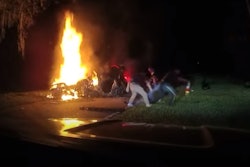Late last month, the Brookhaven (GA) police Department used a UAV (“drone”) as a key asset in the apprehension of two fugitive suspects wanted in connection with armed robbery in North Carolina.
According to WGCL-TV, on May 24, 27-year-old Alton Johnson and 30-year-old Shyquan Collins were booked into the DeKalb County Detention Center on various charges including obstruction after
The suspects' vehicle had been picked up by a license plate reader and officers performed a traffic stop in a pharmacy parking lot where one of the subjects–Johnson–was taken into custody. Collins, however, had fled on foot and an officer operating the UAV was able to track him into a nearby townhome complex and direct the officers to his hiding spot in dry storm-water basin.
This was just the latest in a countless spring of incidents in which a UAV (sometimes called a UAS, for Unmanned Aerial System) was successfully deployed by police. But it requires much more than a passing interest in hobby model flight. Here are some of the keys to training for a role as a police UAV operator.
License to Fly
A hobbyist who operates one of the many millions of quadcopters now available on the consumer market certainly knows how to fly one of those machines, but that doesn't enable that person to do so in a law enforcement of other commercial capacity. This requires the blessing of the Federal Aviation Administration, which can be obtained in one of three ways.
In the first, an agency submits an application for Certificate of Authorization (COA) to the FAA—outlining its intended operations parameters—and awaiting the agency's approval. The COA provides the agency with a great deal of autonomy and latitude because it can then self-certify its operators (which can come with certain risk also), but the wait is long and the results are not guaranteed.
The faster route is for each "drone operator" candidate to pursue their own certification and pilot's license under FAA Rule 14 CFR Part 107. This involves a knowledge exam covering everything from flight operations, applicable regulations, emergency procedures, radio communications, and the like. There are numerous "ground schools" in the private sector that offer preparatory classes.
The third—and most complete—avenue to get well-trained UAV pilots into the agency's ranks is to pursue both paths in parallel, with the PD obtaining a COA and each pilot getting their Part 107 cert. Once the COA has been issued and the pilots have their Part 107 cert, it's strongly recommended that regular training operations continue, ensuring proper adherence to the COA and renewal of those Part 107s.
Taking Flight
Ask 10 young officers what specialized unit they might like to train for as their career progresses and you’ll probably get four saying SWAT, three saying Motors, two saying detectives, and one—maybe one—saying "I want to be a UAV operator."
That person will probably have to invent the position for the department, standing the unit up from the ground level—both figuratively and literally. But they also may find themselves to be temporarily attached to of any one of those special units at nearly any time.
For example, according to the Brookhaven PD website, the 16 officers assigned to the UAS team—each of whom is required to maintain a valid FAA Part 107 Remote Pilot License, responded to 537 calls for service and eight SWAT callouts last year (2021). They were called upon during investigations to take aerial photographs of five crime scenes.
It's good work, if you can get it—and to get it, you have to train for it.
















